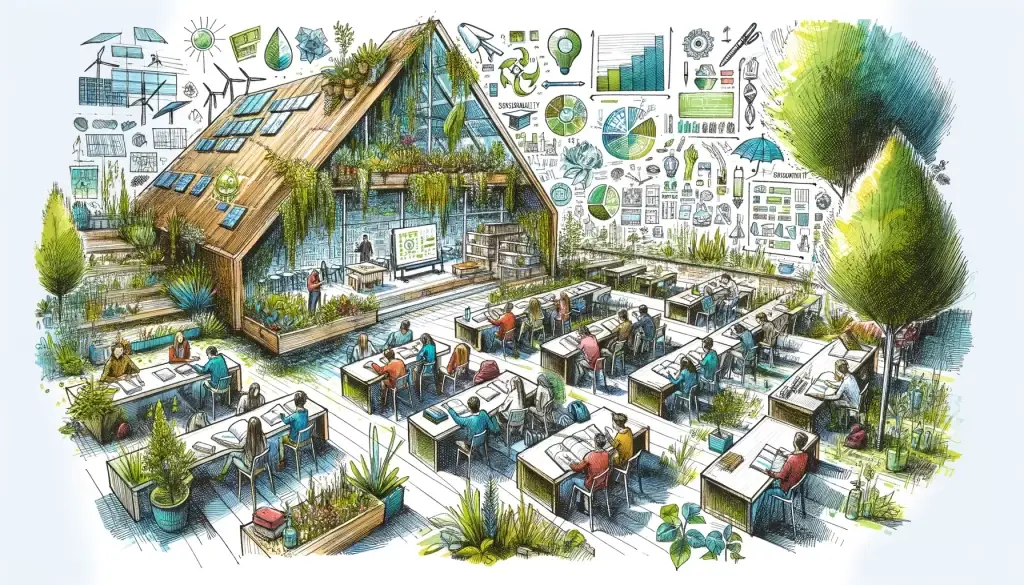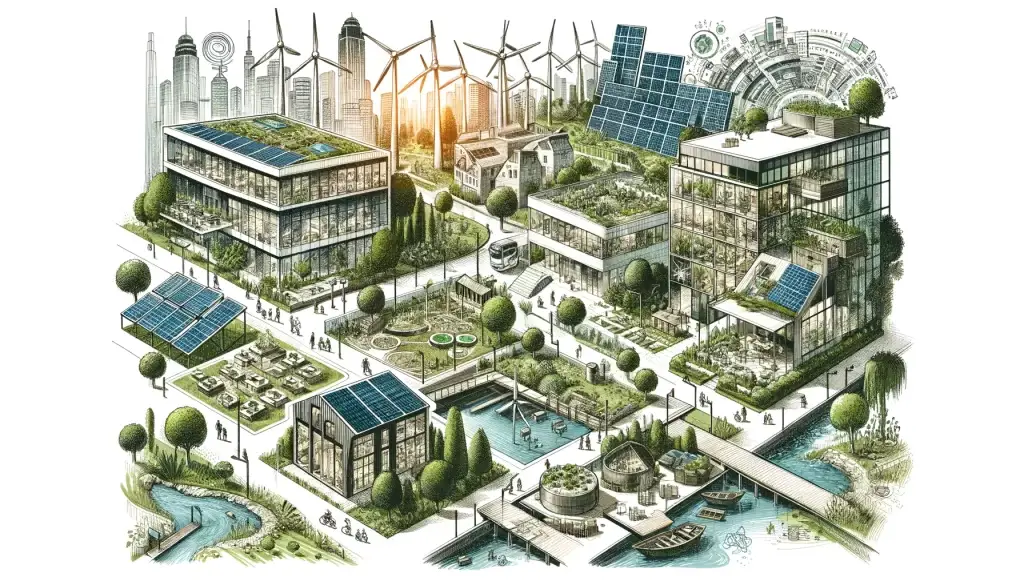The urgent global need for sustainable practices has made it imperative that architectural education evolves to embed sustainability deeply within its curricula. This shift is not merely a trend but a foundational change necessary to prepare architects to tackle the complex environmental challenges of our times.
This essential evolution within architectural education not only aligns with global sustainability efforts but also reflects a profound understanding of architecture’s role in shaping our world. By embedding sustainability into the curricula, educators are preparing students not just to build but to think critically about the environmental, social, and economic impacts of their designs. This transformative educational approach fosters a new generation of architects who are equipped to lead the charge towards a more sustainable future, ensuring that sustainability becomes a natural part of their design philosophy and not just an add-on criterion.

Sustainability in architectural education is no longer optional; it is a critical demand of our era. As Grover, Emmitt, and Copping (2018) emphasise, the design studio, traditionally the heart of architectural education, must transform to integrate sustainability as a core element of its pedagogy. This integration prepares students to consider environmental impacts as a primary aspect of their designs, aligning with Hendawy, Junaid, and Amin’s (2024) insights on the importance of incorporating Sustainable Development Goals (SDGs) into the architectural curriculum.
This critical demand highlights the growing recognition of the interconnectedness of built environments with global sustainability challenges. Incorporating sustainability into architectural curricula empowers students to innovate and apply sustainable solutions from the ground up, integrating ecological considerations throughout the lifecycle of their projects. This shift is not merely about changing a syllabus but about instilling a new way of thinking and designing that prioritises the long-term health of our planet. It’s about nurturing architects who can lead the way in building sustainable communities that thrive economically, socially, and environmentally.
Despite the consensus on its importance, embedding sustainability into the curriculum faces significant hurdles. These include outdated pedagogical models, faculty resistance, and the need for a broader interdisciplinary approach. Laura B. Cole’s (2019) research further highlights the gap in green building literacy among the general public and professionals, underscoring the necessity for educational frameworks that advance understanding and skills in sustainable design.
The hurdles in embedding sustainability within architectural education underscore a broader cultural and systemic shift that is required within educational institutions. This shift challenges not only the content but also the delivery of architectural education, necessitating a break from traditional pedagogies to embrace more dynamic, interactive, and interdisciplinary approaches to learning. Overcoming these obstacles is pivotal for cultivating an educational environment where sustainability is not seen as a separate agenda but as an integral part of architectural thinking and practice.
Addressing these challenges requires innovative strategies that transcend traditional teaching methods. Grover et al.’s (2018) call for a more interdisciplinary approach resonates with Cole’s (2019) framework, which suggests integrating green building literacy as a key component of STEM education. Hendawy et al. (2024) provide examples of pedagogical advancements, such as project-based learning and real-world applications that can significantly enhance students’ understanding and engagement with sustainability.
Innovative pedagogical strategies, therefore, serve as bridges connecting theoretical knowledge with practical application, enabling students to explore, experiment, and embody the principles of sustainable design in their work. These strategies foster a learning environment that encourages students to question, challenge, and rethink the norms of architectural design in light of sustainability principles. This approach is essential for equipping future architects with the creativity, critical thinking, and problem-solving skills needed to address the multifaceted challenges of sustainable design in a rapidly changing world.

A critical component of embedding sustainability is the showcasing of sustainable projects within the curriculum. This not only demonstrates the practical application of sustainable principles but also inspires students by highlighting the innovative possibilities of sustainable design. Cole’s (2019) emphasis on the role of the built environment as a teaching tool aligns with the need to incorporate real-life examples and case studies of sustainable architecture into teaching.
By integrating sustainable projects into the curriculum, educators can offer students tangible examples of what is achievable, broadening their understanding of sustainability beyond theoretical concepts to include practical, real-world applications. This exposure not only serves as inspiration but also as a critical learning tool, allowing students to analyse and critique sustainable designs, understand their impacts, and envision their contributions to advancing sustainability in architecture. It bridges the gap between education and practice, providing students with a clearer vision of their potential to effect change through sustainable design.
Educators and institutions have a pivotal role in this transformative process. As Cole (2019) points out, the development of green building literacy begins in the classroom, requiring educators to integrate sustainability into their teaching methodologies actively. Similarly, Hendawy et al. (2024) underscore the need for institutional support in revising curricula to include sustainability as a core component, reflecting a commitment to training architects capable of meeting the demands of the 21st century.
The commitment of educators and institutions to this transformative process is paramount for its success. It involves creating a culture that values and prioritises sustainability across all aspects of architectural education—from curriculum development to research and community engagement. This commitment must be mirrored in the resources allocated, the experts brought in, and the opportunities provided to students, ensuring that sustainability is woven into the fabric of architectural education. It’s a call to action for educators and institutions to lead by example, demonstrating their dedication to preparing students to be not just architects but stewards of a sustainable future.
The integration of sustainability into architectural education is a complex yet vital endeavour. Drawing upon the insights from Grover et al. (2018), Hendawy et al. (2024), and Cole (2019), it is clear that a multifaceted approach involving curricular innovation, pedagogical strategies, and institutional commitment is essential. By embracing these changes, architectural education can lead the way in preparing future architects to design a sustainable, equitable, and beautiful world.
In conclusion, the journey towards integrating sustainability into architectural education is both a challenge and an opportunity to redefine the role of architects in society. It’s about preparing architects who are not only skilled in sustainable design but also embody the values of sustainability in their professional ethos. This journey requires the collective effort of educators, institutions, and students, united in their commitment to building a sustainable future. By embracing this challenge, architectural education can lay the groundwork for a new era of architecture that harmonises human needs with the planet’s well-being, paving the way for a sustainable, equitable, and beautiful world for generations to come.
Cole, L. B. (2019). Green building literacy: a framework for advancing green building education. International Journal of STEM Education, 6(1). https://doi.org/10.1186/s40594-019-0171-6
Grover, R, Emmitt, S & Copping, A. 2018. ‘Fit for purpose? Sustainability and the design studio’ Paper presented at International conference for the sustainable design of the built environment 2018, London, UK United Kingdom, 12/09/18 – 13/09/18, pp. 257-268.
Hendawy, M., Junaid, M., & Amin, A. (2024). Integrating Sustainable Development Goals into the Architecture Curriculum: Experiences and Perspectives. City and Environment Interactions, 21, 100138. https://doi.org/10.1016/j.cacint.2023.100138
Gucyeter, B. (2016). The Place of Sustainability in Architectural Education: Discussion and suggestions. Athens Journal of Architecture, 2(3), 237–256. https://doi.org/10.30958/aja.2-3-4
Horsthemke, K. (2024). Education, the environment and sustainability. Routledge.
Robert Grover, Stephen Emmitt & Alex Copping (2019) Reflecting on sustainability: coproducing a critical framework for sustainable design in the architectural studio, Higher Education Pedagogies, 4:1, 41-63. https://doi.org/10.1080/23752696.2019.1624589
Sign in to continue
Not a member yet? Sign up now

Administrative Assistant
Deniz Bol is the Administrative Assistant at SPACE Studies, where she supports the day-to-day operations and contributes to the smooth functioning of the organization. Alongside her administrative role, Deniz is an artist with a passion for creative expression. She is currently pursuing her studies at the University of the Arts London (UAL), where she continues to develop her artistic practice. Her organizational skills, paired with her artistic background, make her a valuable asset to the SPACE Studies team, helping bridge the worlds of administration and creativity.
E-mail: denizbol@spacestudies.co.uk

Digital Marketing Consultant
Murat Oktay is the Digital Marketing Consultant at SPACE Studies, where he provides strategic guidance to enhance our digital presence and community engagement. With a keen eye for digital marketing trends and best practices, Murat plays a key role in refining our content strategy, expanding our online reach, and connecting with a wider audience. His expertise in digital tools and innovative marketing techniques aligns with SPACE Studies’ mission as a social enterprise, ensuring that our campaigns are impactful and resonate with our commitment to social responsibility in architecture and design. Outside his work with SPACE Studies, Murat stays at the forefront of digital marketing advancements, continually exploring new tools and sharing his insights with peers.
E-mail: muratoktay@spacestudies.co.uk

Marketing Manager
Santa Noella Matabaro is the Marketing Manager of SPACE Studies, bringing her expertise in strategic planning, community engagement, and relationship-building to the organization’s mission as a social enterprise. With a background in Politics & Law from the University of Kent, Santa combines analytical insights with a creative approach to advancing SPACE Studies’ vision of fostering interdisciplinary dialogue in architecture, design, and urban planning. In her role, she develops targeted campaigns and strategic partnerships, building brand presence and fostering meaningful connections with the community. Santa’s collaborative and people-centered approach enhances SPACE Studies’ impact, aligning with its commitment to social responsibility and innovation in the built environment.

Academic Content Coordinator
Betul Uckan is an architect and dedicated academic with a background in both architectural practice and research. She holds a Master of Science in Architectural Design and a Bachelor’s degree in Architecture from Istanbul Technical University, where she cultivated her interests in architectural theory and design. Betul has gained experience as a research assistant in various universities, contributing to design studios and foundational courses. She has also worked in the field as an architect with projects focused on design, modeling, and construction, and has been involved in notable projects, including Maltepe Piazza and Emaar Square in Istanbul. With her expertise spanning both digital and material architecture, Betul brings a dynamic, interdisciplinary approach to her role as the Academic Programme Coordinator.
E-mail: betuluckan@spacestudies.co.uk

Senior Researcher & Managing Editor
Arghavan Pournaderi is a senior researcher in the field of architectural conservation and restoration, with an academic foundation in architecture and specialized expertise in historic sites and buildings. Completing her PhD at the Art University of Isfahan, Iran, in 2019, her research has contributed to the understanding of Iran’s architectural heritage, with a focus on Isfahan’s urban and architectural evolution during the Safavid period. In addition to her extensive research, Dr. Pournaderi has held academic positions at various institutions in Isfahan, teaching at both undergraduate and graduate levels. Her work extends beyond academia as she contributes to SPACE Studies as Senior Researcher & Managing Editor, where she oversees scholarly initiatives that foster deeper interdisciplinary dialogue in architecture and heritage conservation.

Senior Researcher & Educational Consultant
Gregory Cowan is a Senior Researcher and Educational Consultant at SPACE Studies, where he leads initiatives that bridge academic research and practical application in architecture and urban design. He contributes his extensive experience to mentoring postgraduate students, designing educational workshops, and guiding community-focused projects. Gregory is also a freelance academic at the University of Wales Trinity St David and the University of Westminster, and founder of The Architects Coach. His expertise spans architectural workspace analysis, professional development, and positive intelligence coaching.
E-mail: gregorycowan@spacestudies.co.uk

Senior Researcher
Alison Hand is a Senior Researcher at SPACE Studies. She is a painter and writer with an MA in Painting from the Royal College of Art. Alison’s work focuses on creating absurd, unstable heterotopic spaces and dialogues with painting history. She is currently the Artist in Residence for King’s College London Philosophy Department on the Dreams and Wakeful Consciousness Research Project, exploring themes of time and simultaneity in new work. Alison has received numerous awards for her painting and is currently working with Bloomsbury Publishers on a major essay on Drawing in Contemporary Art. She is also the BA Fine Art Programme Leader at Art Academy London and co-director of Cement Arts. Her role at SPACE Studies involves leading research projects, mentoring junior researchers, and contributing to our artistic and academic initiatives.
E-mail: alisonhand@spacestudies.co.uk

Senior Researcher
Julian Wild is a Senior Researcher at SPACE Studies and the Sculpture Program Leader at The Art Academy London. With over 30 years of experience in creating and exhibiting sculptures, Julian has worked with high-profile clients such as Cate Blanchett and the University of Oxford. A fellow and former vice president (2015-2019) of the Royal Society of Sculptors, his work has been featured at venues like Modern Art Oxford and Chatsworth House. At SPACE Studies, Julian leads research projects, mentors junior team members, and conducts workshops that blend art and urban studies. In his free time, he enjoys attending academic conferences and crafting new sculptures.
E-mail: julianwild@spacestudies.co.uk

Director of Publications & Senior Researcher
Elif Suyuk Makakli (Associative Professor) earned her PhD in Architecture from the Vienna University of Technology, where she studied the impact of technology on architecture under Prof. William Alsop. With extensive experience in architectural practice in Istanbul and Vienna, she is now an Associate Professor at FMV Isik University, focusing on design education and technology. At SPACE Studies, Elif serves as both the Head of Publications and Senior Researcher, guiding scholarly content and contributing to research initiatives. She is dedicated to mentoring and fostering design innovation.
E-mail: elifsmakakli@spacestudies.co.uk

Director of Research
Sanaz Shobeiri is an architect, urban designer, and landscape urbanist, currently a postdoctoral researcher in the Department of Planning at Queen’s University Belfast. Her research focuses on age-gender inclusiveness and the interplay of architectural, historical, political, and sociocultural dimensions in urban spaces, exemplified by her project on city centres in Belfast and Tehran. Sanaz holds a PhD in Urban Planning from the University of Tehran and has a robust portfolio in sustainability and urban theory. As Head of Research at SPACE Studies, she leads innovative research initiatives, fostering collaboration and academic excellence. In her free time, Sanaz enjoys exploring urban landscapes and supporting community development.
E-mail: sanazshobeiri@spacestudies.co.uk

Creative Director
Selin Gulce Sozmen is the Creative Director at SPACE Studies, where she leads the artistic vision and design strategy for the organisation. With a background in graphic design and visual arts, Selin has been instrumental in creating visually captivating books, journals, and event posters. Her role extends to developing and coordinating workshops and creative projects, ensuring that all visual materials meet the highest standards of quality and innovation. Selin’s dedication to creativity and excellence drives the visual and creative direction of SPACE Studies, making her an essential part of the team.
E-mail: selinsozmen@spacestudies.co.uk

Founder & Executive Director
Pinar Engincan is the Founder and Executive Director of SPACE Studies, an innovative social enterprise focused on fostering interdisciplinary dialogue and education in architecture and urban design. With extensive experience as a lecturer and researcher, Pınar holds a PhD in Architecture and has led numerous academic initiatives. Her career includes curriculum development, international collaborations, and research on housing and urban policies. Passionate about bridging academia and community, she champions accessible education and consultancy services, empowering individuals to shape the built environment.
E-mail: pengincan@spacestudies.co.uk